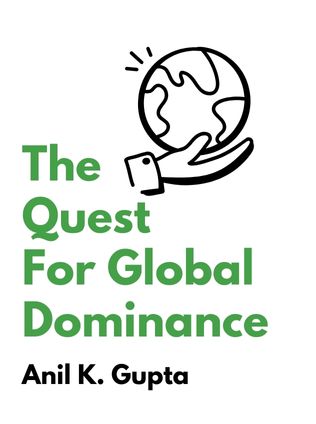
The Quest For Global Dominance
Transforming Global Presence into Global Competitive Advantage
By Anil K. Gupta,
Published 04/2008
About the Authors
Vijay Govindarajan is the Earl C. Daum 1924 Professor of International Business and the director of the William F. Achtmeyer Center for Global Leadership at the Tuck School of Business Administration, Dartmouth College. Anil K. Gupta is a professor of strategy and global e-business at the Robert H. Smith School of Business, University of Maryland at College Park. Both authors are renowned experts in global strategy and business, with extensive experience in advising corporations on how to compete globally.
Main Idea
"The Quest for Global Dominance" emphasizes that globalization is no longer an option but a strategic imperative for businesses. The book outlines how companies can transform their global presence into a competitive advantage by identifying key markets, adapting to local differences, and cultivating a global mindset. The authors provide a framework for companies to navigate the complexities of globalization and leverage opportunities for value creation worldwide.
Table of Contents
- What is Globalization?
- Build a Global Presence
- Exploit Your Global Presence
- Cultivate a Global Mindset
- Change the Rules of the Global Game
- Globalization in the Digital Age
What is Globalization?
Globalization refers to the growing economic interdependence among countries, characterized by increasing cross-border flows of goods, services, capital, and knowledge. This interconnectedness means that businesses must consider global dynamics in their strategies. The extent of globalization varies by country and industry, with some sectors being more integrated than others.
"Globalization refers to growing economic interdependence among countries as reflected in increasing cross-border flows of goods and services, capital and know-how." – Vijay Govindarajan and Anil K. Gupta
- The global wireless industry dominated by Nokia, Motorola, and Ericsson.
- The soft drink industry led by Coca-Cola, Pepsi-Cola, and Cadbury-Schweppes.
Build a Global Presence
Building a global presence involves addressing six key issues: choice of product, choice of strategic market, mode of entry, transplanting corporate DNA, winning the local battle, and speed of global expansion.
Choice of Product
Companies must decide which products to introduce to the global market. This involves evaluating potential return and required local adaptation. High potential return and low adaptation needs are ideal for global expansion.
"Pick a product or service that has high potential return and requires the least amount of reconfiguration." – Vijay Govindarajan and Anil K. Gupta
- Selecting products that align with local preferences and market needs.
- Avoiding products that require extensive modification for new markets.
Choice of Strategic Market
Strategic market selection should be systematic, considering the market's strategic importance and the company's ability to exploit it. High strategic value markets warrant rapid entry, while others may require establishing a beachhead first.
"If the market is of high strategic value but you have limited ability to enter it, consider establishing a beachhead first." – Vijay Govindarajan and Anil K. Gupta
- Entering markets with high growth potential and strategic importance.
- Gradually building presence in challenging markets through partnerships or acquisitions.
Mode of Entry
Companies must choose the appropriate mode of entry, such as exporting, local production, licensing, or joint ventures. Factors like market size, cost efficiency, and local regulations influence this decision.
"The larger the market, the more likely that you will achieve efficiencies of scale by operating locally." – Vijay Govindarajan and Anil K. Gupta
- Setting up local production to minimize shipping and tariff costs.
- Forming joint ventures to navigate local market complexities.
Transplanting Corporate DNA
Transplanting corporate DNA involves embedding core elements of a company's business model and culture in new markets. This requires a dedicated group of employees who can train and instill the company's values.
"Transplanting core beliefs to a company you have acquired requires that a group of true believers in the company be transplanted so that the new beliefs can take root." – Vijay Govindarajan and Anil K. Gupta
- Bringing in expatriates to embed company standards and practices.
- Renovating employee spaces first to signal higher standards and value.
Winning the Local Battle
Winning the local battle involves addressing the needs and actions of customers, competitors, and the host country government. Understanding local market dynamics and building strong relationships are crucial.
Sign up for FREE and get access to 1,400+ books summaries.
You May Also Like
Rich Dad Poor Dad
What the Rich Teach Their Kids About Money - That the Poor and Middle Class Do Not!
By Robert T. KiyosakiFreakonomics
A Rogue Economist Explores the Hidden Side of Everything
By Steven D. Levitt and Stephen J. DubnerThe Lean Startup
How Today's Entrepreneurs Use Continuous Innovation to Create Radically Successful Businesses
By Eric RiesWho Moved My Cheese?
An Amazing Way to Deal with Change in Your Work and in Your Life
By Spencer Johnson, M.D.Factfulness
Ten Reasons We're Wrong About the World – and Why Things Are Better Than You Think
By Hans RoslingMake Your Bed
Little Things That Can Change Your Life...And Maybe the World
By William H. McRaven



















